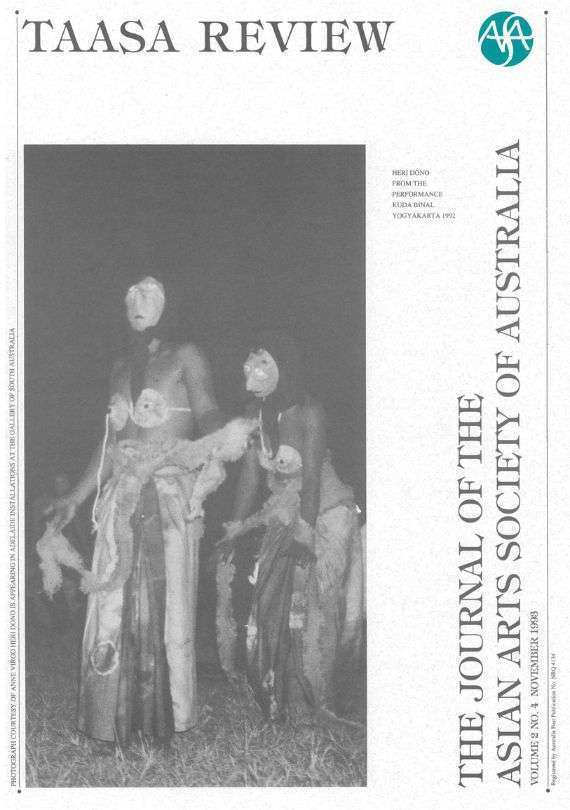TAASA Review Issues
November 1993
Vol: 2 Issue: 4
Editors: Heleanor Feltham & Christina Sumner
Cover Photo
HERI DONO in a performance of Kuda Binal, Yogyakarta 1992. Heri Dono is appearing in Adelaide Installations as part of the 1994 Adelaide Festival. Photograph courtesy of Anne Virgo.
TAASA Members may log in to download a PDF copy of this issue as well as past TAASA Review issues back to 1992.

Editorial
Heleanor Feltham
Like many other members of The Asian Art Society, I have just returned from the First Triennial Asia-Pacific Conference at the Queensland Art Gallery, undoubtedly one of the most exciting, stimulating, occasionally confronting events of 1993.
For those of us who have been promoting Asian-Australian cultural exchange for much of our adult lives, the conference, involving around 400 delegates, artists, academics, from many countries of Asia-Pacific, was a spectacular indicator of a change from neutral to positive in cultural community attitudes. For others, it was a revelation, not simply of the richness and diversity of contemporary art, but of the equal richness and diversity of critical thought and method throughout the region.
The Conference was more than matched by the extraordinary range of works selected for the Asia-Pacific Triennial of Contemporary Art exhibition. 76 artists from 13 countries representing East and Southeast Asia and the South Pacific (including Australia) were represented, 42 of whom were actually present during the Conference adding greatly to its power and integrity. While it is possible to be critical of choices, gender balances, themes seen and excluded, even the composition of the National Committee, this seems almost like habit-formed sniping. Nothing is perfect, yes there undoubtedly were mistakes – but what a magnificent result! and, after all, this is the first, not the one and only, Triennial.
The Triennial conference was followed almost immediately by the ICOM-ASPAC 5th Regional Assembly on the theme of Museums and Cross-Cultural Understanding Ω an ideal follow-up to Brisbane. This major international event in the Museum life-cycle may have attracted fewer delegates, but the countries represented (Asia-Pacific region) were equally diverse, and the speakers equally as passionate in exploring the roles and preoccupations of museums in the mine field of cultural diversity.
Unfortunately for TAASA Review, the two conferences came barely days before the final copy (on disc and off to typesetter) deadline for this issue. Next year, however, we hope to publish several of the papers and some personal assessments of the exhibition and the conference, together with reviews of the excellent catalogue and accompanying book, Tradition and Change.
This current issue of TAASA Review brings to an end our second year of publication. During that time we have published articles on Indian painting and Central Asian carpets, Laotian street art and Chinese revolutionary opera, the industry in fake porcelains and the yin and yang of Japanese architecture, Turkish pottery and Indian textiles, bonsai and bronze bells, Japanese swords and Tibetan culture, the art of coffee and the problems of ARX, and, as the record covers say, many many more. We have profiled our committee, focused on local identities, reviewed books, films and exhibitions, discussed conservation, publicised events, and generally ranged across time and space from bronze-age China to contemporary Australia.
I would like to thank the many contributors, members and non-members, for the quality of their articles, their tolerance of editorial scissoring, and their courtesy in meeting deadlines. I would also particularly like to thank our advertisers, the major institutions who have taken full-page ads to promote significant exhibitions, and that group of dedicated gallery owners, whose regular and elegant advertisements ensure that TAASA Review continues to keep on paying its excellent designer Vicki Reilly – and its printer.
Table of contents
4 COMMENT AUSTRALIAN VISUAL ARTS IN AN ASIAN CONTEXT – Christina Davidson
5 CANBERRA SCHOOL OF ART: RELATIONS WITH ASIA – David Williams
6 PROFILE: OUR NEW STATE REPRESENTATIVES – Dick Richards, Fiona Leibrick, Alan Dwight
8 THE GARDENS OF MUGHAL LAHORE – Dr Michael Brand
10 MAO GOES POP: POLITICS OF THE AVANT GARDE IN CHINA – Huangfu Binghui
12 INDONESIAN TEXTILES: TRADITION AND CHANGE – Christina Sumner
14 ADELAIDE INSTALLATIONS: PLACE IN POSITION FOR USE 1994 Adelaide Festival
16 ONCE UPON A TIME IN CHINA (PARTS I AND II): TSUI HARK AND HIS CHINESE COMPLEX – William Cheung
18 IDENTITIES RUTH BURGESS: AN AUSTRALIAN PRINTMAKER IN CHINA – Victoria Hynes
20 FILMS THE WEDDING BANQUET, THE STORY OF QIUJU – Heleanor Feltham
22 BOOKS
CHINA 1890-1938: FROM THE WARLORDS TO WORLD WAR CHINA: A PHOTOHISTORY 1937-1987 – James Hayes
BOOK NOTES – Neil Manton
THE UNESCO ASIA PACIFIC ARTS DIRECTORY
24 IN THE PUBLIC DOMAIN OBJECTS IN PUBLIC COLLECTIONS – Fiona Leibrick
25 THE SYDNEY DUCKITT COLLECTION OF JAPANESE AND CHINESE IVORIES: REPORT ON A LONDON SALE – Robert Bradlow
26 REVIEWS AND PREVIEWS Exhibitions, Lectures, Events and Performances
28 MEMBERS DIARY – James Hayes and Ross Langlands
BECOME A MEMBER
To download a PDF copy of this issue as well as past TAASA Review issues, receive discounted entry to industry events and participate in exclusive study groups, join the TAASA Community today.
TAASA Review Issues
2025
2024
2023
2022
2021
2020
2019
2018
2017
2016
2015
2014
2013
2012
2011
2010
2009
2008
2007
2006
2005
2004
2003
2002
2001
2000
1999
1998
1996
1995
1994
1993
1992
TAASA Review Issues
2025
2024
2023
2022
2021
2020
2019
2018
2017
2016
2015
2014
2013
2012
2011
2010
2009
2008
2007
2006
2005
2004
2003
2002
2001
2000
1999
1998
1996
1995
1994
1993
1992